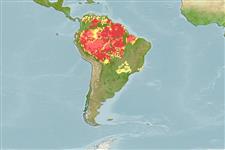Classification / Names
Common names | Synonyms | Catalog of Fishes (gen., sp.) | ITIS | CoL | WoRMS | Cloffa
Actinopterygii (ray-finned fishes) >
Gymnotiformes (Knifefishes) >
Sternopygidae (Glass knifefishes)
Etymology: Eigenmannia: From Eigenmann, 1910, researcher of faunistic studies (Ref. 45335).
Environment / Climate / Range
Ecology
Freshwater; benthopelagic; pH range: 6.0 - 7.0; dH range: 2 - 15. Subtropical; 20°C - 30°C (Ref. 12468), preferred ?
South America: widely distributed east of the Andes from the Orinoco to the La Plata River basins.
Length at first maturity / Size / Weight / Age
Maturity: Lm 11.0, range 11 - ? cm
Max length : 44.0 cm SL male/unsexed; (Ref. 96624); max. published weight: 113.60 g (Ref. 111130)
Known to be gregarious, timid and nocturnal (Ref. 27188). Prefers deep still waters (Ref. 75964). Found in ponds (Ref. 11229) and creeks with a substrate rich in plant debris (Ref. 12225). This gymnotiform fish can be found in colder waters of 18°C (Ref. 10011). Electric organ discharge (EOD) frequency cues have been experimentally shown to play a role in species and sex recognition in this species (Ref. 10598). Playback of a conspecific male's electric courtship display elicited spawning in ripe females. Diel rhythmic change in EOD may be manifested by the increase in EOD amplitude at night among dominant breeding males as they compete with other conspecifics (Ref. 10599). A fractional spawner; fecundity reported at 905 eggs (Ref. 10605). Males reportedly reach 45 cm TL, females to 20 cm TL (Ref. 1672).
Lays 100-200 eggs which adhere to leaves of aquatic plants (Ref. 27188).
Albert, J.S., 2003. Sternopygidae (Glass knifefishes,Rattail knifefishes). p. 487-491. In R.E. Reis, S.O. Kullander and C.J. Ferraris, Jr. (eds.) Checklist of the Freshwater Fishes of South and Central America. Porto Alegre: EDIPUCRS, Brasil. (Ref. 39524)
IUCN Red List Status (Ref. 115185)
CITES (Ref. 94142)
Not Evaluated
Threat to humans
Harmless
Human uses
Fisheries: of no interest; aquarium: commercial
More information
Age/SizeGrowthLength-weightLength-lengthLength-frequenciesMorphometricsMorphologyLarvaeLarval dynamicsRecruitmentAbundance
Tools
Special reports
Download XML
Internet sources
